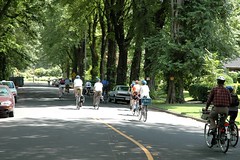
get calmer, safer, and more
enjoyable for bikes in the
coming months.
(Photo © J. Maus)
At a subcommittee meeting before the monthly Bicycle Advisory Committee meeting in City Hall last night, the Portland Bureau of Transportation’s Traffic Safety Program Manager Mark Lear and Traffic Safety Specialist Greg Raisman outlined details on the bike boulevard portion of Mayor Adams’ “First 100 Day Action Plan”.
In that list, Mayor Adams promised to,
“Identify 15 miles of Bicycle Boulevards for implementation in the coming year,” and to “Complete the next link in the Bike Boulevard network on N Wabash, connecting N Willamette Blvd to the bike path along the Columbia River.”
Lear acknowledged that even though the 100 days are considered business days (which puts the deadline out to May), “there’s a lot of work to do.”
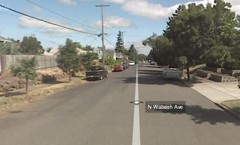
Portland’s next bike boulevard.
To make that work easier, Lear and Raisman said they’re focusing on streets that already have “favorable conditions”. That is, streets that have low traffic speeds, low traffic volume, relatively safe/easy crossings, are connected to the existing bike network and neighborhood services, and that are “fundable”.
The City likes Wabash for all the reasons above and because it connects at the south end with bike lanes on N. Willamette Blvd and with the terminus of N. Bryant Ave (already a popular bike street that will be a bike boulevard in the future). From there, Wabash goes north for about a mile, and eventually (after it turns into N. Hamlin) goes all the way to the Columbia Blvd. Bike Path.
“Wabash has a lot going for it, but no one knows it’s there.”
— Greg Raisman, PBOT
“Wabash already has a got a lot going for it,” says Raisman, “but no one knows it’s there.”
In addition to Wabash, two other bike boulevard projects are already pegged to be included in the first 15 miles: in Southeast Portland, Spokane Blvd. from the river to SE 21st; and Going Street, from N. Concord to NE 74th (both of these projects have been kick-started by advocates — Spokane by a neighborhood group, and Going by the BTA).
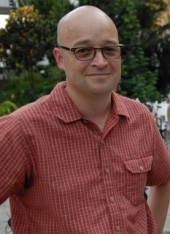
the bike boulevard effort for PBOT.
(Photo © J. Maus)
With money tight at PBOT these days, funding for this initial group of bike boulevards will be cobbled from three non-transportation department sources: “urban renewal” funds from the Portland Development Commission (PDC), “green street” project funding from the Bureau of Environmental Services (BES), and finally, from a from a fund set aside for community traffic safety projects at PBOT that is generated from traffic fine revenue.
Lear said that PBOT will meet internally this week to discuss the next steps in the process. By the next Bicycle Advisory Committee meeting (February 10th), he said they will have an update on the first three projects (with budget estimates and outreach proposals for each) along with a draft list of more potential bike boulevards that “fit into this operational strategy”.
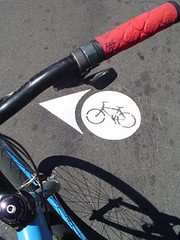
will have much larger
pavement markings than
existing ones.
(Photo © J. Maus)
As for identifying and choosing the final list, Lear says they’ll make their best attempt to distribute them throughout the city (“it’s a matter of geographic equity” he said). To find the routes, they’ll focus on the work that has already been done in the Bike Master Plan update. One area that is likely to be included is Southwest Portland. (Hilly and circuitous, that area of the city is bike facility deficient, but a massive, citizen-led effort to identify bike boulevards has helped routes in that area move up on PBOT’s priority list.)
What will be like to ride on these new bike boulevards? Lear says PBOT will unveil a new bike boulevard pavement marking (much larger than the existing “dots”). “The experience you can expect will be pleasant and and you will feel comfortable riding side-by-side.” Lear added that they’re trying to “flip as many stop signs as possible” and that there will be “some level of partial street closure”.
The idea is to make it obvious — whether you’re in a car or on a bike — that the street is meant for bicycle travel.
Working to fulfill promises made in Adams’ First 100 Day Action Plan is just one part of the City’s two-pronged effort for bike boulevards. PBOT is also working hard to make sure they’re at the front of the line to receive money for bike boulevards in President-elect Barack Obama’s in-process economic stimulus bill. Lear says they’re saving the “more complex and expensive” projects for federal funding.



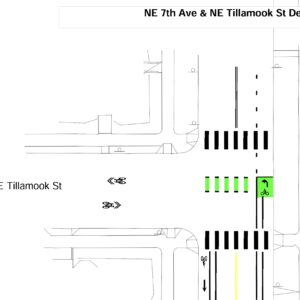

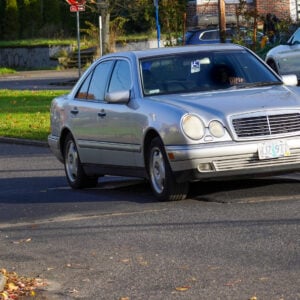
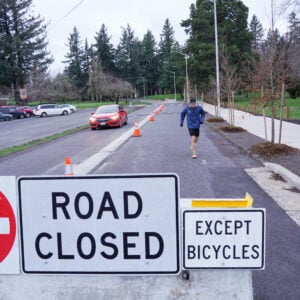
Thanks for reading.
BikePortland has served this community with independent community journalism since 2005. We rely on subscriptions from readers like you to survive. Your financial support is vital in keeping this valuable resource alive and well.
Please subscribe today to strengthen and expand our work.
This is fantastic. I’m especially pleased by the fact that the items mentioned are rather inexpensive (i.e. flipping signs) where what is happening is essentially redesign of what already exists versus building new. Motorist traffic diverters have some cost but they will HUGELY impact these streets in a positive way. Homeowners should like it because it eliminates cut-through driving on residential streets and increases home values.
That said, what truly makes routes efficient and safe are clean solutions to crossing major arterials. If I’m rolling with my kids, it doesn’t matter that *part* of the route is nice, if I’m forced to cross MLK (for example) without the right controls, I’ll pick a different route.
What does it mean to “flip a stop sign?” If that means that the street flowing into the bike boulevard has a stop sign whereas the bike boulevard does not, I’m not sure I’m in favor. I live in SE on Lincoln St. in the 30s. There is a stop sign at 30th and another at 34th, followed by the light at 39th. While I agree that it is great for bikes to not have to stop, the more stop signs you lose, the more cars you are going to attract. 5-6pm in front of my house has tons of bikes, yes, but also tons of people cutting through to 39th, usually speeding. The speed bumps and traffic circles don’t really do much to slow them down. They just hit the bump and fly on by. I saw a Portland “City that Works” station wagon whip past the other day, but it was too grime covered from the recent snow to be able to read the plate (Going fast enough that I actually looked to see if I could report to someone how fast this person was driving in a residential neighborhood). One way traffic – that might help.
AHR, I’m totally with you in that flipping signs could also attract motorized traffic as well. This can be mitigated two ways
1) Cyclist traffic being high enough to calm the street AND those riding do so with some confidence, forcing motorists to slow down.
2) Adding diverters so these routes cannot be used as shortcuts for motorists. I like the diverters where practical because cyclists need to feel safe all the time on a route. If we the safety is not reliable then there will be few families on the routes which in turn increases safety.
If drivers are not diverted off the roads at regular intervals these are not bike blvds they are just more bike friendly streets. Without hawk signals or under/overpasses or other ways to cross major streets these are not bike blvds they are just more bike friendly streets. Little white dots or big white dots do not good blvds make. Routing traffic off these roads is essential and where Portland has failed with most of the blvds currently in place. Please do the job right so that families and timid riders will recognize these changes as they drive buy and realize they can get on there bikes and enjoy it.
Yeah, I don’t really get why designating a street as a bike boulevard changes anything substantive. Asking drivers to avoid those streets or “be more careful” is like asking heavy industry to regulate its own pollution. I’d love to see ornamental planters/barriers every 4-5 blocks which are wide enough for bikes to ride through without losing speed, but impassable by cars. Locals can still park in front of their homes, shoppers can drive right up to storefronts, but the street is no longer a viable through street for motorized vehicles.
Wabash already has speed bumps, so I don’t expect a significant increase in auto traffic from switching the stop signs. The logical place to put a diverter on it would be Lombard, but I don’t see ODOT going for that. I (and a lot of other people,) are working on getting trucks off of Lombard and onto Columbia Blvd, and getting Lombard made into a neighborhood main street, (right now it is that, but it is also a state highway, and the “highway” part is winning,) but I don’t see the highway being moved, and PBOT taking the street over before May, (although maybe. It depends on if we get Federal stimulus money to fix the problems on Columbia Blvd.)
Also, it is going to connect to the Columbia River bike path? To do that, it will, among other things, need to cross the Slough, which means either a new bridge over the slough, (I don’t see that happening before May,) or the Blvd would divert to either the sewage treatment plant bridge a mile west, or Denver Ave bridge a mile east, both of which are served by bicycle routes already. Maybe they mean the bike path along Columbia Blvd?
However, more important than all that, Wabash crosses Lombard right next to Mock’s Crest Tavern.
I live one block off Lombard at Denver.
Lombard is an utter nightmare, especially the Denver intersection. I have to pass through it twice daily, and it is easily the most nerve wracking part of my ride (or drive for that matter). From about MLK, West, it is a horrible street with no bike lanes, many speeding vehicles (many of them large), and tons of red light violations.
To me, cleaning up Lombard would take nothing short of a complete miracle.
When I see cyclists riding it, I literally cringe and get the chills (not the good kind).
One day at the 7-11 there, there were THREE cop cars interrogating a single, 5’4″ man, clearly unarmed. I watched 2 cars run the red as the light changed. Sigh. I have never seen a single basic traffic stop at that intersection in the 5 years I have lived there.
Read here:
http://www.bta4bikes.org/at_work/bikeboulevards.php
on BTA’s website for more about bike boulevards and how they’re optimized for bikes while reducing car traffic.
I would like to see more diverters in neighborhoods. The main argument against them on arterials is emergency access. If these diverters lie off of the main arterial, they do not adversely affect emergency (and resident) access, increase home values, and make short-cuts not so short for speedy motorists.
Will older existing bike Blvd’s be retrofitted with the new larger logo…?
JayS is right about traffic diversion.
We need to divert these folks and their cages off the Bike B’s both existing and pending. Anytime I’ve discussed this very point with PDOT/PBOT folks they list 12 reasons why it’s either not needed or not do-able.
I don’t buy it.
If we needed to divert any other traffic for the sake of motorists there would be no hesitation…
just sayin’
I sure hope something larger than the size of a beer coaster is chosen. Many times I’ve told drivers that the road they’re on is a bike boulevard and they had no idea. Check out what they did in Berkeley, where every street sign has a bike symbol. It’s important to put up markings where drivers are looking, not just where cyclists can see them.
One word. Bollards.
about 3 and a half feet tall, bright yellow, concrete-encased steel girders.
Put 4 of these in the middle of every other block on the bike blvd.
Put a swift end to neighborhood ‘Rat Runs’ Not as attractive as planters, but not as expensive either, and little to no maintenence.
You could stencil the bike symbol on the side of them. Go crazy and put the reflective stuff like in crosswalk paint.
it would be nice if they made NE 21st through irvington one of those boulevards.
Having a close call more than once, I’m trying to create more bike awareness (by cars, I’m thinkin’) in a friendly way that doesn’t pit cyclists against cars. http://www.cafepress.com/littlebayroot/6352009
I love the first couple of comments. Very cool.
but the best quote is, “Asking drivers to avoid those streets or “be more careful” is like asking heavy industry to regulate its own pollution.” That’s just brilliant.
For those who are interested in better traffic calming, there’s already a diag. diverter here atHoughton Street.
But regarding the Columbia Slew issue, it’s unfortunate that Hamlin is about halfway between the crossing at Denver and the crossing at N Portland Rd.
It’s a nice step in the right direction overall
i would love it if we could bring jan gehl to portland to have him consult and share his thoughts on improving public spaces in the city especially bike and pedestrian infrastructure. he is currently consulting in seattle and nyc.